Blog
April 21st, 2015

It’s that time of year again—the annual Tacoma Wayzgoose (our local letterpress and book arts extravaganza) is just around the corner! This will be the eleventh year of the event, and we’re expecting a record crowd. Because attendance has grown so much over the years, we’re expanding to meet the demand. For the first time ever, Wayzgoose will now be a two-day event, with artist vendors and steamroller printing on both days:
11th Annual Tacoma Wayzgoose
Saturday and Sunday, April 25-26, 2015
11 am to 4 pm, Free!
King’s Books
218 St. Helens Avenue, Tacoma, WA
Jessica and I are sitting out the steamroller printing this year, to give more newbies a chance to play, but we will both have tables inside. So make sure to stop by and say howdy, and see all the new goodies we’ll have there!
As always, I like to give a run-down Wayzgeese Past—and the list is getting mighty long! So if you’re new here and don’t know what a Wayzgoose is, or you just want to relive the glory days, here are my posts from previous years:
• 2009 (Tacoma)
• 2010 (Tacoma)
• 2011 (Tacoma)
• 2011 (San Francisco)
• 2012 (Tacoma)
• 2013 (Tacoma)
• 2014 (Tacoma)
All fired up? Good. See you this weekend!
The Tacoma Wayzgoose is a collaboration between King’s Books and Springtide Press with support from the Tacoma Arts Commission. Steamroller Printing is possible through a partnership with neighboring businesses Doyle’s Public House, the Harmon Tap Room, and The Hub. Many thanks to legions of volunteers who make this event possible, especially from our local institutions including Pacific Lutheran University, University of Puget Sound, Charles Wright Academy, Stadium High School and Tacoma Community College.
March 15th, 2015

One of the highlights of my recent trip was finally getting to see an illustration subject in person. Back when Jessica and I created our On a Mission Dead Feminist broadside a few years ago, we did a ton of research about San Antonio and the Alamo—but neither of us had ever actually been there in person. So you can imagine how much I geeked out when I visited the place—especially when I saw a plaque explaining how our girl Adina De Zavala is responsible for saving and preserving the place.
Here’s hoping there are many more Dead Feminist field trips in the future!
February 20th, 2015
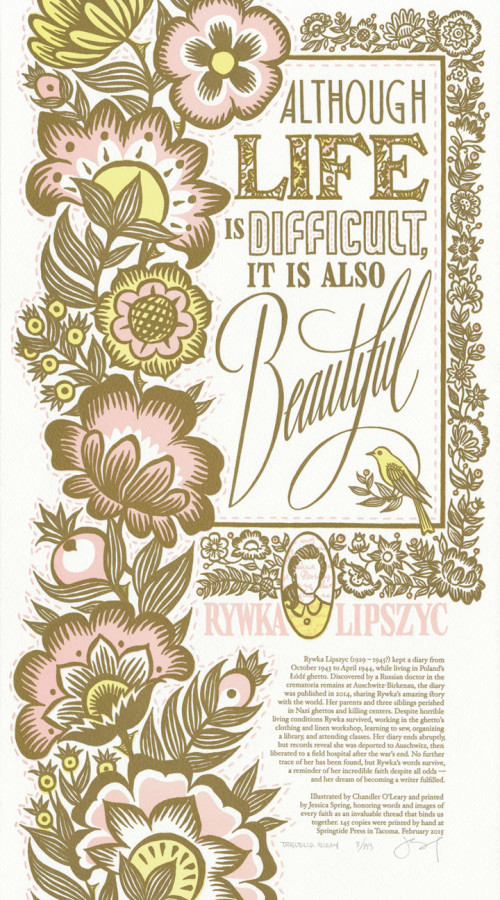
For our last broadside, we focused on a woman from the Islamic world; now we’re back with an homage to Judaica. The juxtaposition of the two pieces was no accident on our part. Yet the timing of world events was something we could never have planned. We originally meant to tie our new piece in with the 70th anniversary of the liberation of Auschwitz—last month, the anti-Semitic terrorist attacks in Paris gave us a terrible new perspective for our piece.
What really bowled us over is that the young woman we chose to highlight for the new piece underscores the relationship between the two events, the two time periods in history. You see, our gal is a historical figure, yet the world has only just discovered her. So here we present to you the words of a young writer, whose diary, along with her faith, carried her through one of the darkest times in human history:
Although life is difficult, it is also beautiful. — Rywka Lipszyc (pronounced “Rivka Lipschitz”)
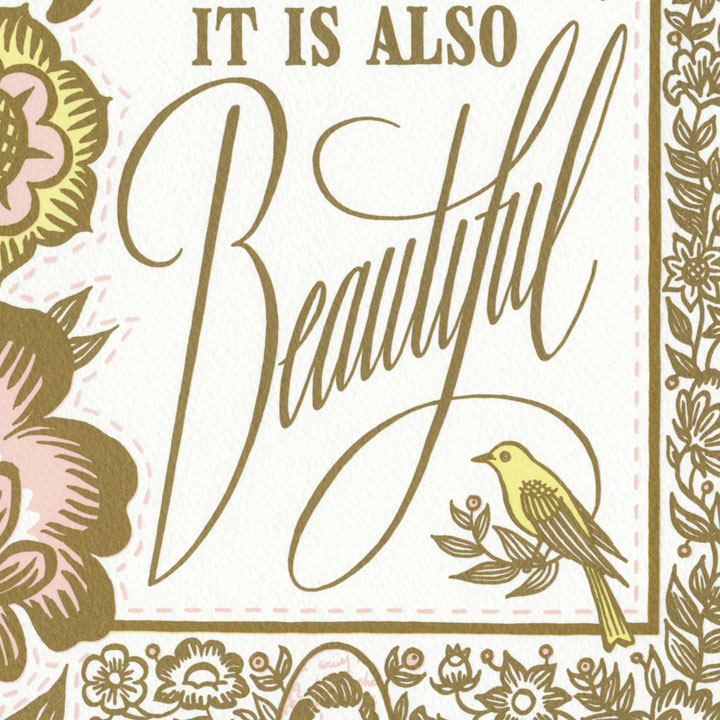
Rywka’s story is astonishing, if only for the fact that it can be told at all. Rywka was a teenager living in one of the worst Jewish ghettos of Nazi-occupied Poland during World War II. By the time she started her diary at age fourteen, she had already lost all but one of her family members. While working as a factory seamstress and caring for her younger sister, she poured her heart and faith into the pages of her notebook. At times the diary is a harrowing account of wartime hardship; at others, it reads like the missives of any normal, modern teenage girl. The pages are dense but not numerous: just a few months after it begins, the diary ends abruptly—and with it most of our knowledge of Rywka’s life. We know she was deported to Auschwitz a few months later; and that her sister was murdered upon arrival at the camp. We know she was liberated from Auschwitz by allied troops 70 years ago—but then her trail goes cold, like that of so many other victims of the Holocaust. Historians are sure she did not survive for long after the liberation, but that’s all they’re sure of: no further details of Rywka’s fate have been uncovered. No photo of her exists, nor any other trace of her life beyond the diary, a few registration records, and the memories of a trio of surviving cousins living in Israel.
What is truly remarkable is that the diary survived the war, the camps and the intervening decades. A Russian army doctor allegedly found the diary in the ashes of the Auschwitz crematorium. The doctor made a few notes in the margins, and then put it away in her closet at home—for the rest of her life. Upon her death, her son found the diary, and then he stashed it away for several more decades. When he died, his daughter—the granddaughter of the army doctor—traveled back to Russia from the U.S., and found the diary among his effects. This time, however, she knew just what to do with it. She took it back with her to the States, and turned it over to the JFCS Holocaust Center in San Francisco. They then authenticated and translated the diary—and published it in book form less than a year ago.
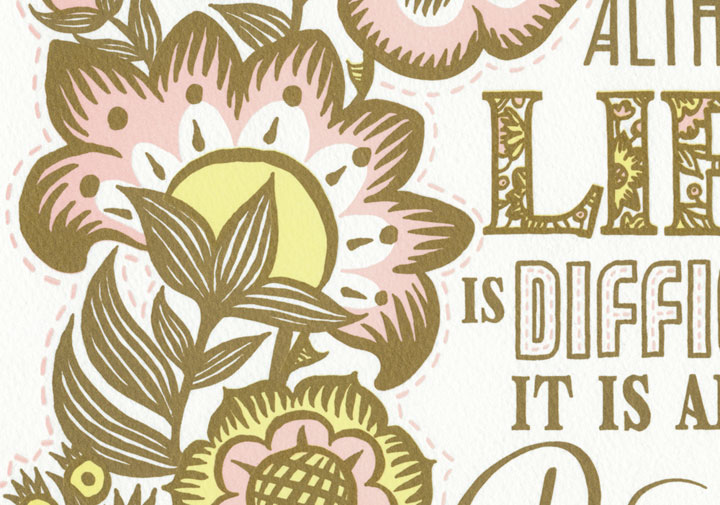
Jessica and I were able to get a hold of the new publication at the Pacific Lutheran University library (many thanks to Holly Senn for tracking the book down for us!). In reading the text, we were struck by Rywka’s use of metaphor—particularly her mentions of flowers growing among thorns. So we took Rywka’s imagery and wove the broadside’s design and theme around it.
Common Threads is a winter garden of pale pastels and subtle metallic golds. The delicate colors and shining metallic ink (which includes real gold in the formula) represent the fragility and preciousness of life among the thorns of war and persecution. The floral motif echoes themes from Rywka’s diary, and stands for the resilience of the Jewish people—whose culture has flourished beautifully despite some of the worst trials endured by humankind.
The overall design of the broadside is based on Rywka’s dual cultural heritage. The border is reminiscent of Jewish embroidered challah covers and sabbath cloths, while the style of floral illustration is derived from Polish folk florals. The stitched lines are a nod to Rywka’s trade as seamstress, which she viewed optimistically as a way to move forward and make a living in a future beyond wartime.

To help fight anti-Semitism worldwide and defend civil rights for all, we are donating a portion of our proceeds to the Anti-Defamation League — one of the nation’s top human and civil rights organizations for over 100 years.
• • • • • • • • • • • • • • • • • • • • • • • • • • • • • • • • • • • • • • • • • • • • • • • • • • • • • • • • • • • •
Common Threads: No. 21 in the Dead Feminists series
Edition size: 145 prints
Poster size: 10 x 18 inches
Printed on an antique Vandercook Universal One press, on archival, 100% rag (cotton) paper. Each piece is numbered and signed by both artists.
Colophon reads:
Rywka Lipszyc (1929 – 1945?) kept a diary from October 1943 to April 1944, while living in Poland’s Łódź ghetto. Discovered by a Russian doctor in the crematoria remains at Auschwitz-Birkenau, the diary was published in 2014, sharing Rywka’s amazing story with the world. Her parents and three siblings perished in Nazi ghettos and killing centers. Despite horrible living conditions Rywka survived, working in the ghetto’s clothing and linen workshop, learning to sew, organizing a library, and attending classes. Her diary ends abruptly, but records reveal she was deported to Auschwitz, then liberated to a field hospital after the war’s end. No further trace of her has been found, but Rywka’s words survive, a reminder of her incredible faith despite all odds — and her dream of becoming a writer fulfilled.
Illustrated by Chandler O’Leary and printed by Jessica Spring, honoring words and images of every faith as an invaluable thread that binds us together.
Now available in our new web shop!
• • • • • • • • • • • • • • • • • • • • • • • • • • • • • • • • • • • • • • • • • • • • • • • • • • • • • • • • • • • •
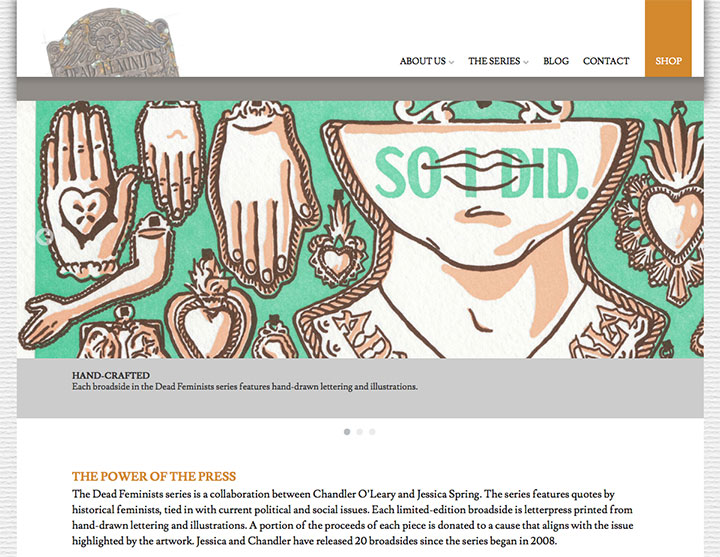
Speaking of which, we finally have a website dedicated to the Dead Feminists series. It has been years in the making, and while we haven’t quite worked out all the kinks yet (bear with us on that), we’re thrilled to be up and running at last. Many thanks to our amazing web designers, Elizabeth Anderson and Paul Ferguson, for making it all happen!
On the new site you’ll find the stories behind each broadside in the series, glimpses into our process, information about our live events, and of course the new web shop (which contains all our broadsides and postcards). So head on over and take a gander!
February 11th, 2015
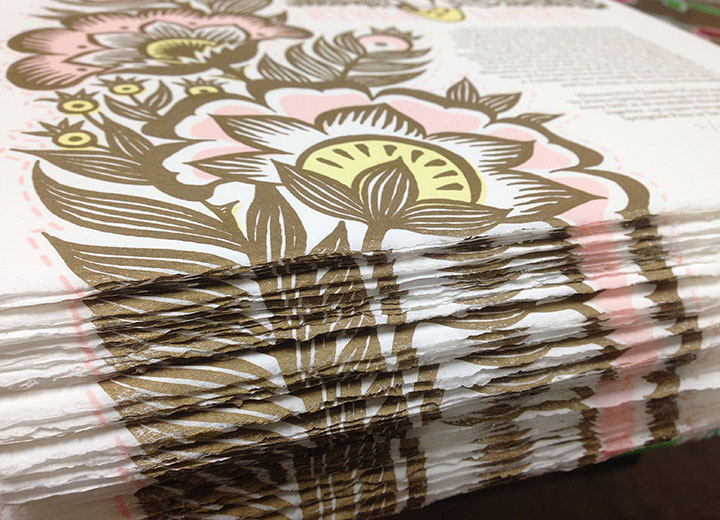
Today is the last day of CODEX, and since people there have been able to see this thing already, Jessica and I thought we should give you a glimpse as well. Look for the new Dead Feminist broadside to appear online at the end of next week!
December 11th, 2014
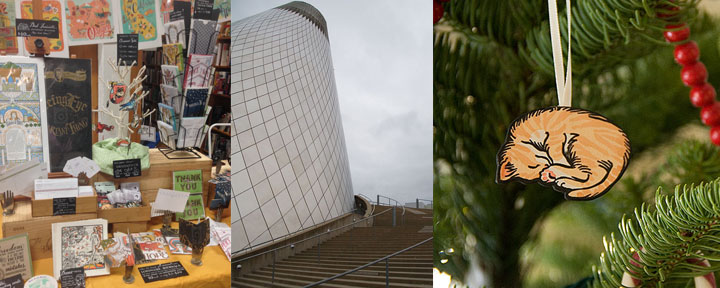
I’m doing one last craft fair this season, and this time it’s at a brand new venue. Tacoma’s Museum of Glass is hosting its first-ever holiday craft fair, featuring 10 local artisans in the beautiful space of the Grand Hall. So if there’s something you still need to cross off your list, you can find it here:
Museum of Glass Holiday Craft Fair
This Saturday, December 13, 2014
10 am to 5 pm (during museum open hours)
1801 Dock Street, Tacoma, WA
See you this Saturday!
October 14th, 2014

Both Jessica and I have solo shows on display right now, and while they deal with different topics, our similar personalities and interests made for a surprising number of overlaps. While we were marveling at how much our shows had in common with each other (which was especially funny, considering that neither of us saw the other’s exhibit until both were installed!), it occurred to us that it might be fun to have our receptions on the same night.
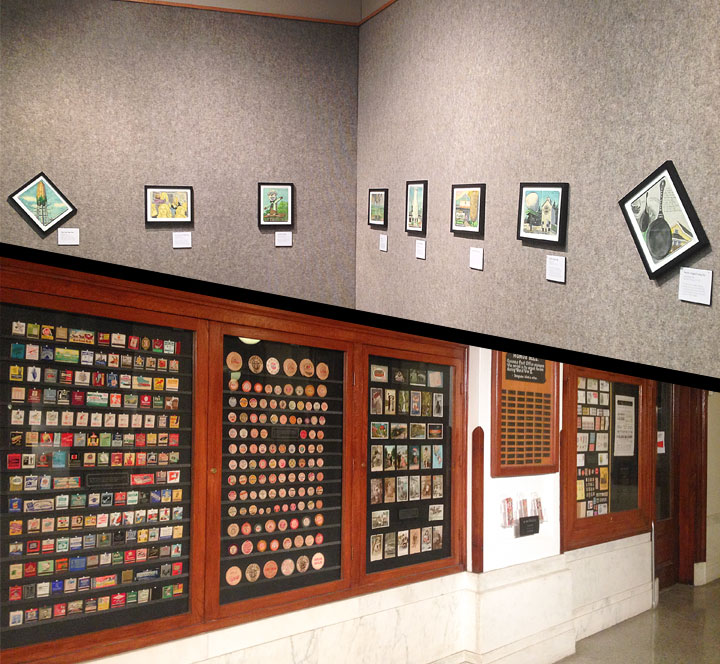
So we joined this month’s Third Thursday Artwalk and created a mini gallery crawl of our own. Here’s how it works: stop by my reception at the Tacoma Public Library first and pick up a letterpress keepsake. Then take your keepsake down the hill to Jessica’s reception at the Old Post Office (which is exactly 5 blocks from the library), and print a phrase on it with her antique printing press. Both events are free and open to the public. We’ll also have a small pop-up shop at Jessica’s reception, stocked with goodies related to our shows and also featuring guest artist Mare Blocker.

Here’s the skim milk:
Third Thursday Art Walk: Dual Exhibition Receptions
Stop 1: Drawn the Road Again
Solo exhibition by Chandler O’Leary
4 to 5:30 pm
Tacoma Public Library Handforth Gallery
1102 Tacoma Avenue South
Stop 2: reCollection
A Spaceworks installation by Jessica Spring
5 to 9 pm
Old Tacoma Post Office, north end of lobby
1102 A Street

Put on your walkin’ shoes, and we’ll fire up the press—see you on Thursday!
August 26th, 2014
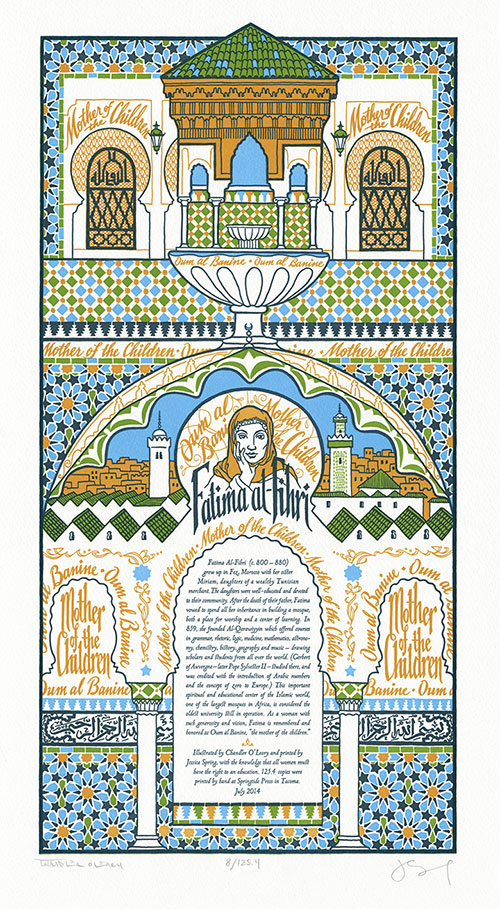
At long last, Jessica and I are ready to unveil our newest Dead Feminist broadside—a piece that has been weighing heavily on our hearts and minds. Our journey began in April, when over 200 girls were kidnapped from their school in Chibok, Nigeria. Since then the media has been filled with accusations leveled at Islam—a culture we know to have a long history of valuing education, innovation and knowledge. We also know that the danger of extremism knows no cultural boundary—and that it would benefit us all to build a world where every girl has the opportunity and security to obtain an education.
So after months of exhaustive research, we decided to go back in time to some of the earliest days of higher education, and to the life and work of Fatima al-Fihri—the woman who founded Al-Qarawiyyin, the oldest university still in operation today. Because Fatima lived in the 9th century, no direct quotes have made it to the present era. Instead, the piece highlights Fatima’s honorific title: Oum al Banine, or “Mother of the Children.”
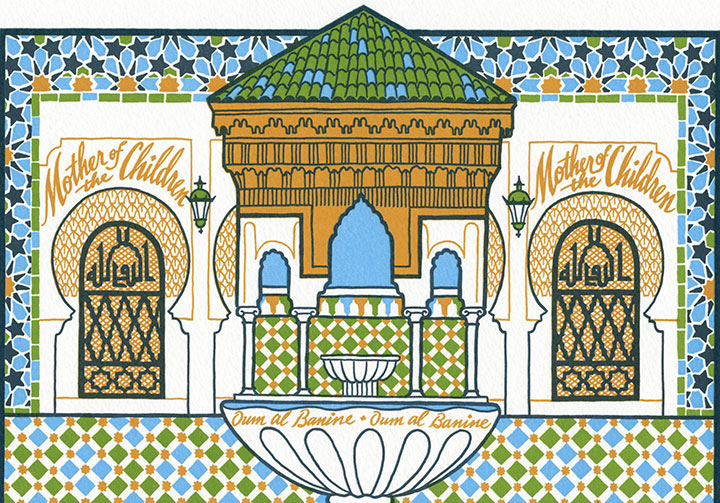
The phrase weaves through the piece like the mortar between stones, repeating again and again like a mantra. The design mirrors the Arabesque decorative style, as well as the common practice of decorating Muslim houses of worship with text (often phrases from the Qur’an). Because it is forbidden to depict the Prophet in Islam, architecture is usually adorned with text and geometric patterns instead.

I spent a long, long time creating this illustration—not only because of all the ornate patterning, or the carefully-researched Arabic script. Not just the time I spent trying to find images of Al-Qarawiyyin, or information about Fatima’s life. Somehow, the act of creating this illustration became something of a mantra in itself. All the time required to draft these patterns and compose the page became a form of meditation—and I needed that with this piece. Because much more than that, this became an exercise in trying to understand.
I was trying to understand why we had so much trouble finding a voice for this piece. Why we had to go back 1200 years to find a woman like Fatima, who had made a lasting contribution and who was remembered. Why we could not find a relevant, direct quote at all, despite months of research and consulting scholars on this topic. Why it is so difficult and dangerous for a girl to obtain an education in so many parts of the world. Why there is so much violence and hatred and fear surrounding a belief system with so much beauty inherent within it. Why we are still asking these basic questions after so many centuries have passed.
The answers did not come with the completion of the drawing. They did not come off the press with the finished prints. They will not come through my fingers as I type this. If they cannot come as a result of war, or negotiation between heads of state, or elected office, or royal birthright, or the swell of the mob—they won’t come from me.
But I do know this: every human life is worth the same, and deserves the same chance in life. And more than anything else, I know that education, even at its most basic, is the best chance anyone can have to make a good life—for themselves, and for the rest of us. Education is the best defence we know against extremism, poverty, and violence. So this is where we begin. Where we should always begin.

Our 20th Dead Feminist broadside is an ornate tribute to Fatima’s world and the institution she founded. The composition, structured like a Persian manuscript page, features an illustration based on the architecture of Al-Qarawiyyin, with its angular rooflines and sweeping curved arches. Interspersed thoughout the piece is a hand-drawn geometric pattern that mirrors the tilework throughout the university and mosque. Wrapping around the “walls” behind a pair of columns is the Basmala (the phrase that begins every sura or chapter of the Qur’an), lettered in Arabic script.
To help ensure the safety and quality of girls’ education worldwide, we are donating a portion of our proceeds to Girl Up — a nonprofit campaign of the United Nations Foundation that assists some of the world’s hardest-to-reach adolescent girls.
• • • • • • • • • • • • • • • • • • • • • • • • • • • • • • • • • • • • • • • • • • • • • • • • • • • • • • • • • • • •
The Veil of Knowledge: No. 20 in the Dead Feminists series
Edition size: 125.4***
Poster size: 10 x 18 inches
Printed on an antique Vandercook Universal One press, on archival, 100% rag (cotton) paper. Each piece is numbered and signed by both artists.
Colophon reads:
Fatima Al-Fihri (c. 800 – 880) grew up in Fez, Morocco with her sister Miriam, daughters of a wealthy Tunisian merchant. The daughters were well-educated and devoted to their community. After the death of their father, Fatima vowed to spend all her inheritance in building a mosque, both a place for worship and a center of learning. In 859, she founded Al-Qarawiyyin, which offered courses in grammar, rhetoric, logic, medicine, mathematics, astronomy, chemistry, history, geography and music — drawing scholars and students from all over the world. (Gerbert of Auverge — later Pope Sylvester II — studied there, and was credited with the introduction of Arabic numbers and the concept of zero to Europe.) This important spiritual and educational center of the Islamic world, one of the largest mosques in Africa, is considered the oldest university still in operation. As a woman with such generosity and vision, Fatima is remembered and honored as Oum al Banine, “the mother of the children.”
Illustrated by Chandler O’Leary and printed by Jessica Spring, with the knowledge that all women must have the right to an education.
Available now in the Dead Feminists shop!
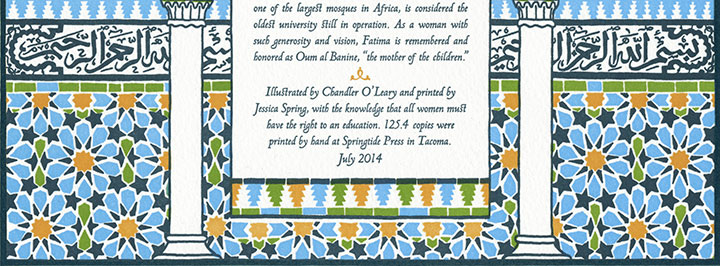
*** The edition size needs a little explanation—every broadside has a symbolic edition number, but this piece is extra special. This number is the solution to an equation we devised out of numbers that are highly symbolic in Islam. Arabic culture is credited with the invention of algebra—a term derived from an Arabic word meaning “the reunion of broken parts.” We arrived at our edition number by multiplying 66 (the number that represents Allah in Islamic numerology) by 19 (considered by some mystics to be the “Key to the Q’uran”), and then dividing the result by 10 (ten-pointed stars are common elements in Arabesque patterning, as well as our broadside design). The “.4” in our edition number represents four artist proofs that exist outside the numbered edition, and set aside as gifts for four important women in our lives. These four women mirror the four “Women of the First Rank in Islam” (Khadijah, first wife of the Prophet; Fatimah, the fourth daughter of Khadijah and the Prophet, and the wife of the Fourth Caliph; the Virgin Mary; and Asiya, wife of the pharaoh and stepmother to Moses).
August 11th, 2014
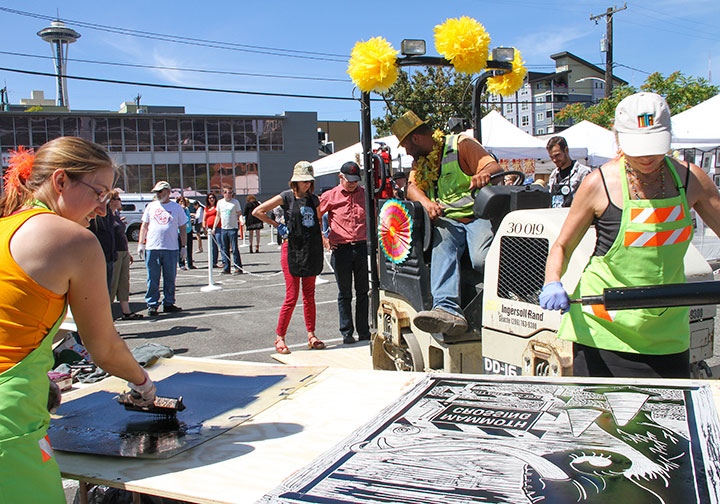
Friday was the perfect day to get outside and invade South Lake Union with a bunch of crazy letterpress shenanigans.

For the first time, the SVC Wayzgoose was wrapped up within the South Lake Union Block Party—so some changes were in order this year. For one thing, it meant a bigger crowd and a wider audience—all good things, if you ask me.

Also, there were provisions nearby!
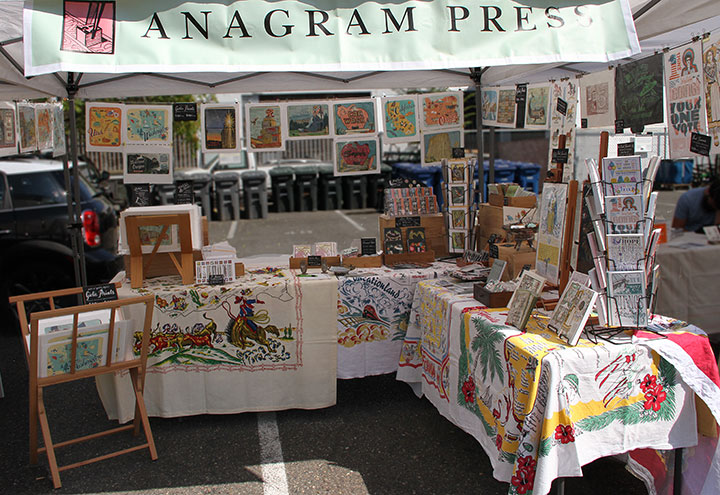
Thanks to the Block Party folks, I also got to expand my operations from a small table into a full ten-foot booth—which felt positively luxurious!
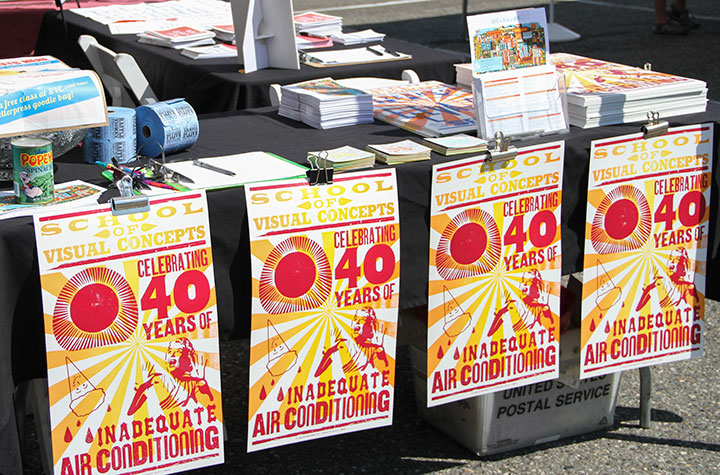
So yeah. Between the perfect summer weather and the friendly, enthusiastic crowd…
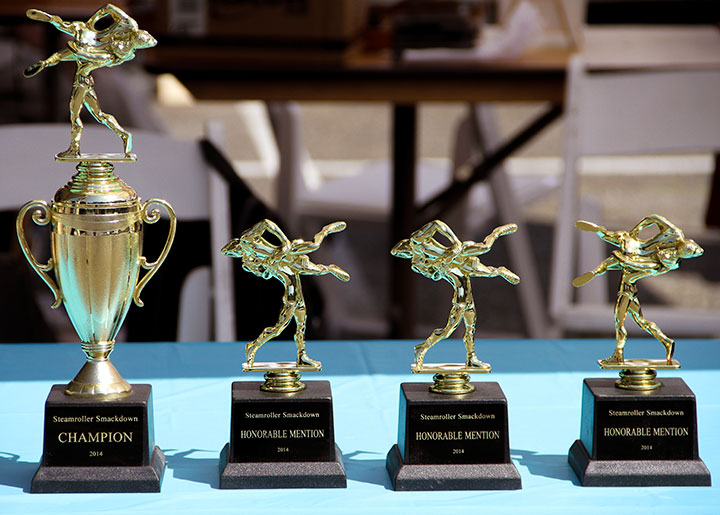
…I think we have a winner.
August 7th, 2014
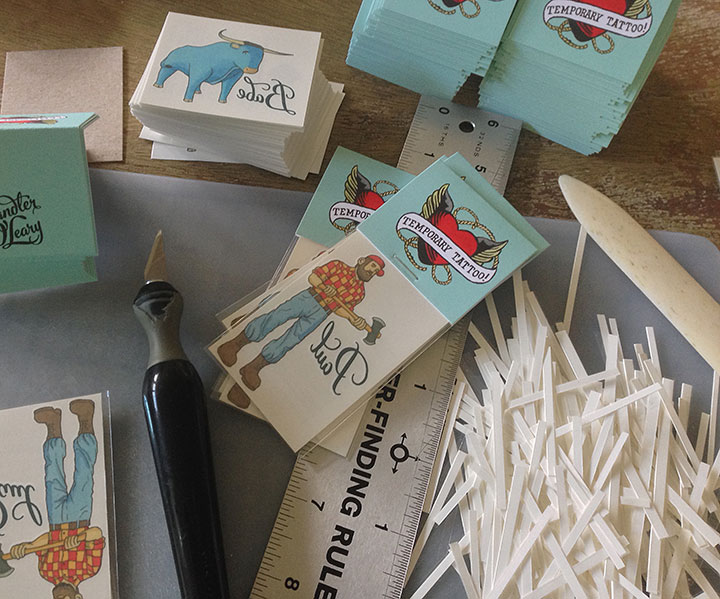
I’m spending today packaging goodies and bagging prints, because tomorrow I’ll be hanging out at the annual SVC Wayzgoose in Seattle. Since SVC is in the process of moving into new digs, this year we’re doing things a little differently: for the first time, the Wayzgoose is wrapped up into the South Lake Union Block Party. We’ll be taking over a hunk of pavement near 9th and John, where SVC will be hosting artist booths, printing demos, and their annual Steamroller Smackdown. Here are the details:
SVC Wayzgoose (South Lake Union Block Party)
Friday, August 8, 2014
12-6 pm, free!
Near the corner of 9th and John (on the edge of Denny Park)
Find me at the Anagram Press booth (#71, in the Wayzgoose section)
More details and map here
See you tomorrow!
July 28th, 2014

Jessica has our new broadside on press as I type this, lining up the colors and doing one last check for typos. But this week also holds another kind of “typo” for us, the kind we actually encourage: typophiles.
While our schedules prevent us from actually being there in person, I’m happy to announce that many of our Dead Feminist broadsides will be exhibited this week as part of TypeCon 2014 in Washington, DC. Since it began in 1998, TypeCon has been a major gathering point for designers, typographers and letterers—as well as a nexus for typography as an art form. So we’re incredibly excited and honored to have our work featured among so many talented artists. So if you happen to be attending TypeCon this week, stop by the gallery and take a gander—and tell everyone hi for us!

![Chandler O'Leary [logo]](https://chandleroleary.com/wp-content/themes/chandleroleary/images/logo.png)
























